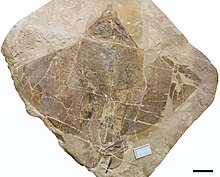| Dasyomyliobatis Temporal range: Late Ypresian, 50–49 Ma PreꞒ Ꞓ O S D C P T J K Pg N ↓ | |
|---|---|

| |
| Holotype specimen | |
| Scientific classification | |
| Domain: | Eukaryota |
| Kingdom: | Animalia |
| Phylum: | Chordata |
| Class: | Chondrichthyes |
| Subclass: | Elasmobranchii |
| Order: | Myliobatiformes |
| Family: | †Dasyomyliobatidae Marramà et al, 2023 |
| Genus: | †Dasyomyliobatis Marramà et al, 2023 |
| Species: | †D. thomyorkei |
| Binomial name | |
| †Dasyomyliobatis thomyorkei Marramà, Villalobos-Segura, Zorzin, Kriwet & Carnevale, 2023 | |
Dasyomyliobatis is an extinct genus of prehistoric stingray in the monotypic family Dasyomyliobatidae, of the order Myliobatiformes. It contains a single species, D. thomyorkei, known from fossil remains from the Early Eocene-aged Monte Bolca Lagerstätte of Italy. The specific epithet references the English musician and Radiohead vocalist Thom Yorke.
The genus is characterized by a unique hybrid dentition and pectoral fin morphology that allowed the shift from undulatory (undulating the ends of the fins in repeated waves) to oscillatory (flapping the fins up and down) swimming. This change in locomotion and dentition likely led to a shift from a benthic to pelagic lifestyle, and to exploit a variety of prey from soft-bodied to hard-shelled organisms. As suggested by the genus name, it displays intermediate traits between the whiptail stingrays (Dasyatidae) and the eagle rays (Myliobatidae), and can thus be considered a transitional form in the origin of pelagic rays. Dasyomyliobatidae is thought to represent a sister group to the Myliobatidae, and the two groups likely diverged during the Late Cretaceous.

The Monte Bolca formation is thought to represent a shallow sea of the Tethys Ocean with scattered coral reefs and seagrass beds. With its combination of traits, Dasyomyliobatis may have been able to forage in both these shallow-water ecosystems as well as the open ocean.
References
- Dasyomyliobatidae - Zoobank.org
- ^ Marramà, G.; Villalobos-Segura, E.; Zorzin, R.; Kriwet, J.; Carnevale, G. (2023). "The evolutionary origin of the durophagous pelagic stingray ecomorph". Palaeontology. 66 (4). e12669. Bibcode:2023Palgy..6612669M. doi:10.1111/pala.12669. PMC 7614867. PMID 37533696.
- Anderson, Natali (2023-11-13). "50-Million-Year-Old Fossil Helps Clarify Origin of Pelagic Lifestyle and Durophagy in Stingrays | Sci.News". Sci.News: Breaking Science News. Retrieved 2023-11-27.
| Radiohead | |||||||||
|---|---|---|---|---|---|---|---|---|---|
| Studio albums |
| ||||||||
| Compilation albums | |||||||||
| Remix albums | |||||||||
| Live albums | |||||||||
| EPs | |||||||||
| Singles |
| ||||||||
| Other songs | |||||||||
| Video albums | |||||||||
| Related albums | |||||||||
| Related articles |
| ||||||||
| Taxon identifiers | |
|---|---|
| Dasyomyliobatidae | |
This article about prehistoric Batoidea is a stub. You can help Misplaced Pages by expanding it. |